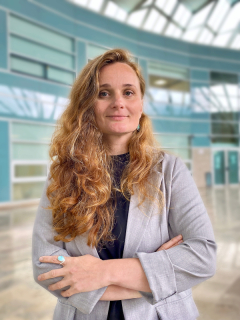CIC biomaGUNE, the Center for Cooperative Research in Biomaterials, has set up a new research group focusing on Bottom-up cell Biology and Bioengineering; it is seeking to explore the molecular processes involved in bacterial cell biology, namely, how bacteria form and reorganize their cell walls, divide, and communicate with each other or with their host organism. A fundamental understanding of these processes could point to novel strategies to fight a major societal and health problem: antibiotic resistance. The research group led by the Ikerbasque Research Fellow Natalia Baranova is aiming to reverse-engineer molecular assemblies to understand how they function.
Reverse-engineering molecular interactions is a classical approach in the field of synthetic biology. In this field, “we rebuild cellular processes from the bottom-up”. To do this, they often use elements (or building blocks) from nature and reassemble them, often with the purpose of making better use of their potential. “In fact, we are bridging engineering and biology. We take molecular components apart and rebuild them again (similar to what we do for cars or bridges). That way, we can reveal why nature has selected these particular components as critical, i.e., we seek to understand the relationship between molecular makeup and ultimate biological function. However, unlike a machine unit, let us say a car motor, molecular interactions are highly adaptive to the environment. I find this particularly beautiful and exciting; focusing on the interactions in the ‘molecular world’, we can identify completely new engineering strategies” explained the researcher.
By rebuilding the molecular processes involved in bacterial cell growth, division, and interaction with the host tissues, “we want not only to explain the key processes in bacterial cell biology but also to search for clinically relevant strategies to fight bacterial infections. It is not only fundamental knowledge we gain, we can further optimize the molecular design and target it to solve a particular societal problem,” added Natalia Baranova.
Bacterial cell wall and biofilms
Bacteria are very small in size, and it remains extremely difficult to probe dynamic molecular interactions directly in living cells. For instance, we do not have a complete picture how bacteria can reorganize their cell wall, or peptidoglycan (a mesh-like layer surrounding the bacterial membrane) during growth and division. “In my past research, I reconstituted peptidoglycan synthesis from the bottom-up. So what I have at my disposal is a platform where we can investigate the mechanism behind such remodeling down to a single-molecule level,” as Baranova explained.
In bacterial cell biology, attention mostly focuses on a single cell, while communities of bacteria forming biofilms receive less attention. Biofilms are layers made up of communities of micro-organisms surrounded by a protective matrix. They are highly dynamic, bulky assemblies that selectively regulate the composition of their matrix to adapt to various environmental conditions or host organisms. Bridging the gap between the molecular organization of a biofilm, cell functions, and macroscale properties of such complex assembly remains difficult.
However, according to Dr Baranova, “using bottom-up reconstitution, we are in a position to fill this gap. We can rebuild the synthetic biofilm matrix and correlate it with natural biofilms. This will enable us to explore why biofilm infections are difficult to target by means of conventional antibiotics, why immune cells fail to recognize them, or how bacterial communities explore the host tissue environment in chronic infections.”
In the opinion of Aitziber L. Cortajarena, the scientific director of CIC biomaGUNE and Ikerbasque Research Professor, “Dr Baranova’s work on synthetic molecular systems addresses significant scientific and societal challenges, particularly the generation of biofilm matrices to tackle the growing issue of antibiotic resistance. This research will provide new tools and platforms for developing innovative antibacterial treatments or for evaluating antibacterial drugs, which are directly translatable to clinical and industrial applications.”
Dr Natalia Baranova is delighted about the new challenges she is addressing: “CIC biomaGUNE is a leading research institute internationally with expertise in biomaterials, biophysics, glycobiology, and the recently established area of 3D-printed adjustable materials. The unique technical infrastructure and scientific expertise make the center highly attractive for the development of my research. Also, thanks to the translational focus of CIC biomaGUNE, our synthetically rebuilt systems may not only address key fundamental questions, but also find a range of applications. Basically, some aspects of my research are highly interlinked and were shaped by the unique scientific environment at CIC biomaGUNE.” She is very motivated “to showcase the scientific excellence of this institute. I expect that my extensive collaboration network will contribute in this respect. I am also keen to assemble a multicultural, interdisciplinary team and transfer my background in bottom-up reconstitution, cell biology and high-resolution imaging to my future students.”
About Natalia Baranova
The Ikerbasque Research Fellow at CIC biomaGUNE Natalia Baranova graduated with an MSc in biochemistry from the Kyiv National University (Ukraine). She joined the group led by Dr Ralf Richter (CIC biomaGUNE, Donostia-San Sebastian, Spain) for a PhD project focusing on the reconstitution of a hyaluronan-rich extracellular matrix in a bottom-up approach. Natalia Baranova has research experience at the Institute of Science and Technology Austria and the University of Vienna (Austria). In her research career she has been awarded a European Molecular Biology Organization Post-Doctoral Fellow, a Human Frontier Science Program Post-Doctoral Fellow, and Marie Jahoda and Ramon y Cajal grants.

